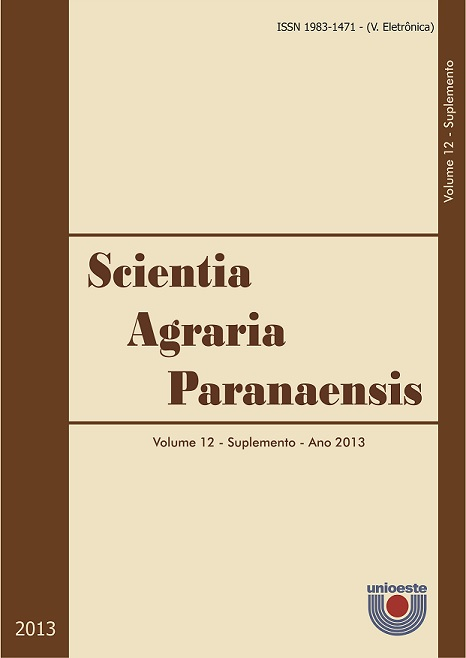Comportamento do milheto na safrinha em função do espaçamento entre linhas e da densidade de semeadura
DOI:
https://doi.org/10.18188/sap.v12i0.9555Keywords:
arranjo populacional, produção de biomassa, Pennisetum glaucumAbstract
The objective of this study was to evaluate, in the dry season, the influence of row spacing and seeding rate in biomass production and in other characteristics of agronomic interest of pearl millet (Pennisetum glaucum L.). The experimental design was randomized blocks in factorial scheme 4 x 2, with four repetitions: the first factor represented by row spacing (22.5; 45.0; 67.5 and 90.0 cm) and second factor represented by seeding rate (25 and 50 kg ha-1 of seeds), in plots of 12.5 m2. The pear millet sowing (was used a common cultivar), was performed manually, in march 2010. Were evaluated, in flowering, the characteristics: plant height, number of leaves of main tiller, number of tillers per plant, number of panicles, length of panicles, fresh mass and dry mass. In the second crop, the production of biomass, in the flowering, decreases as increases the row spacing in millet crop, higher biomass of production is obtained when using smaller spacing. Why other hand, higher production biomass is obtained when using largest sowing density (50 kg ha-1 of seeds). The height of plants, the number of tillers per plant and the number of panicles contributed to obtaining of a higher biomass.
Downloads
Published
How to Cite
Issue
Section
License
Aviso de Direito Autoral Creative Commons
Política para Periódicos de Acesso Livre
Autores que publicam nesta revista concordam com os seguintes termos:
1. Autores mantém os direitos autorais e concedem à revista o direito de primeira publicação, com o trabalho simultaneamente licenciado sob a Licença Creative Commons Attribution que permite o compartilhamento do trabalho com reconhecimento da autoria e publicação inicial nesta revista.2. Autores têm autorização para assumir contratos adicionais separadamente, para distribuição não-exclusiva da versão do trabalho publicada nesta revista (ex.: publicar em repositório institucional ou como capítulo de livro), com reconhecimento de autoria e publicação inicial nesta revista.
3. Autores têm permissão e são estimulados a publicar e distribuir seu trabalho online (ex.: em repositórios institucionais ou na sua página pessoal) a qualquer ponto antes ou durante o processo editorial, já que isso pode gerar alterações produtivas, bem como aumentar o impacto e a citação do trabalho publicado (Veja O Efeito do Acesso Livre).
Licença Creative Commons
Esta obra está licenciada com uma Licença Creative Commons Atribuição-NãoComercial-CompartilhaIgual 4.0 Internacional, o que permite compartilhar, copiar, distribuir, exibir, reproduzir, a totalidade ou partes desde que não tenha objetivo comercial e sejam citados os autores e a fonte.


